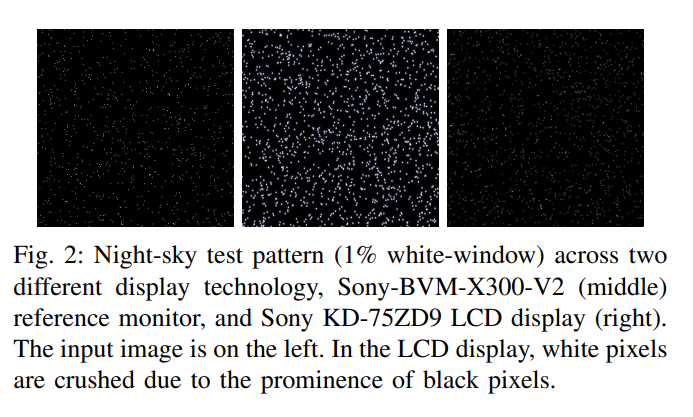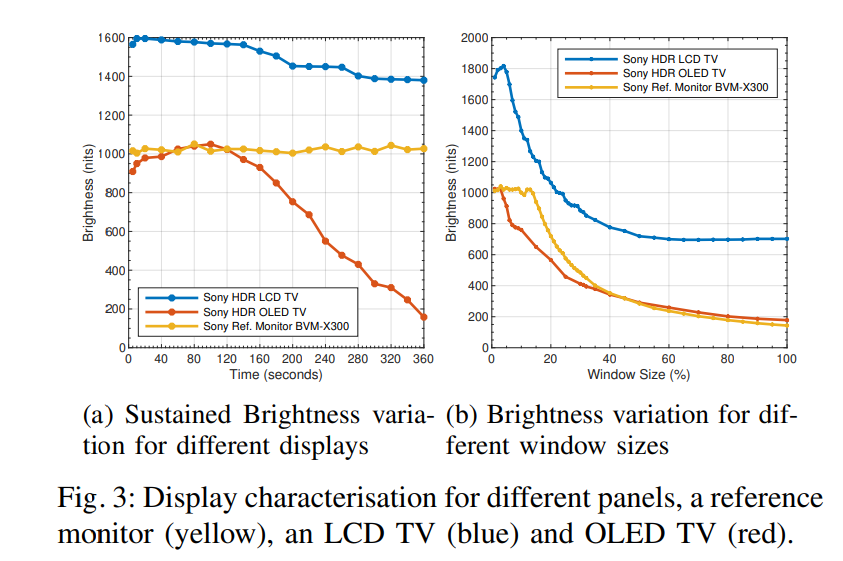Author:
(1) Vibhoothi,Sigmedia Group, Department of Electronic and Electrical Engineering, Trinity College Dublin, Ireland (Email: [email protected]);
(2) Angeliki Katsenou, Sigmedia Group, Department of Electronic and Electrical Engineering, Trinity College Dublin, Ireland & Department of Electrical and Electronic Engineering, University of Bristol, United Kingdom (Email: [email protected]);
(3) John Squires, Sigmedia Group, Department of Electronic and Electrical Engineering, Trinity College Dublin, Ireland (Email: [email protected]);
(4) Franc¸ois Pitie, Sigmedia Group, Department of Electronic and Electrical Engineering, Trinity College Dublin, Ireland (Email: [email protected]);
(5) Anil Kokaram, Sigmedia Group, Department of Electronic and Electrical Engineering, Trinity College Dublin, Ireland (Email: [email protected]).
Table of Links
III. HDR SUBJECTIVE TESTING WORKFLOW
To ensure conformity with the modern HDR standard (ITU BT.2100 [11]), we require to validate multiple factors for the HDR quality assessment framework. The framework consists of three distinct parts. The first part is for the playback pipeline which includes cross-checking the playback, brightness, colour, and bit-depth of the display device. The second part is for handling intermediate file conversions. Finally, the third part concerns the testing environment.
A. Playback Pipeline
- Playback: Figure 1 outlines the typical playback pipeline to be used in a testing workflow. The initial part of the workflow is conversion and making the source into an encoderfriendly format (More in Section III-B). When it comes to HDR video playback, many software video players across different operating systems (OS) do not support true-HDR playback. This is either due to the limitation of hardware or software support (lack of implementation or OS-level support).

To circumvent this problem, we recommend using dedicated hardware for video playback. In this work, we utilised a Blackmagic Decklink 8K Pro Playback device [14] in a Linux environment, where a build of FFmpeg [15] software with Blackmagic support is used for video playback. Alternatively, the open-source GStreamer, or vendor-specific playback software (e.g. DaVinci Resolve [16] can be utilised.
Extension to consumer displays. In modern HDR consumer displays (televisions, or monitors), signalling metadata (colour primaries, transfer characteristics, matrix coefficients etc) is essential for HDR playback. Often, the hardware playback device or any converters which are used in the pipeline would strip the HDR metadata which can result in SDR playback. We recommend forcing HDR metadata on the device end, in cases where it is not available, an intermediate device that inserts HDR metadata is advised (e.g. Dr HDMI from HDFury [17]).
Signal Validation. When multiple sets of hardware devices (including various cables) are used in the playback pipeline, signal integrity (or statistics/existence) should be checked. To this end, and for signal passthrough, we recommend using a cross-converter/waveform monitor (we used Atmos Shogun 7).
2) Displays: The next milestone to accomplish true HDR video playback is the reliability of the television/monitor’s display panel in use. For this, at least five aspects should be observed: i) the ability to programmatically set the HDR settings in the display device, ii) option to turn off vendor-specific features for picture quality enhancement (tone-mapping, auto brightness limiter (ABL), gradation etc) iii) faithful tracking of the electro-optical transfer function (EOTF) in use (PQ) for both low and high-luminance areas, iv) the ability to display at least 1000 nits of brightness for at least 5-10% window, v) Behaviour of sustained brightness over the period. Keeping all of these in consideration, we are utilising a Sony BVM-X300v2 OLED critical reference monitor as a source of reference, along with two consumer-level LCD (Sony KD75ZD9) and OLED (Sony A80J) HDR display televisions.
Local dimming analysis. To analyse the display panel’s local dimming, blooming effect, and colour-bleeding artefacts, we developed a night-sky-star test pattern [18]. This pattern randomly distributes different percentages (1, 2, 5, 10, 20, 50, 80%) of peak-white pixels across the display resolution. Figure 2 showcases the behaviour of a 1% white window with a reference monitor (middle) and the Sony LCD TV (right). We advise using this artificial test pattern for measuring the

true behaviour of the panel over real night-sky patterns as they are prone to ISO camera noise. We later measured the brightness of a small area where most pixels are i) black, and ii) white. If a significant increase of brightness over window size for both is observed, the panel is susceptible to poor local dimming. In our study, we observed the brightness of the LCD panel increased linearly based on the number of white pixels, and the OLED panel showcased superior local dimming.
3) Brightness: Many of the current consumer displays have ABLs that do not allow peak brightness beyond a certain window size (gradually decreases) and/or sustained peak brightness over time. Many displays include this to protect the display units. Thus, we recommend analysing i) the sustained brightness using a 1% full white window; ii) the brightness variation over different window-size. In EBU’s Tech Report 3225v2 [6], it is recommended to test the peak brightness (L) of the TVs using a full-white window at four levels of screen area (S) (4, 10, 25 and 81%). In our analysis, we discovered that four points may not be sufficient to model the true behaviour of consumer displays. We recommend expanding this by including more steps S ∈ {1 . . . 5, 7, 10, 12, 15, 20, 25, 30, 40, 50, 60, 75, 80, 90, 100}%. Figure 3a shows the sustained brightness of 1% window observed for a period of 600 seconds for the three considered display units. As easily observed, the reference monitor (yellow line) consistently sustains the brightness. The LCD TV (blue line) sustained high brightness for a long period (≈180 sec for >=1500nits). The OLED TV (red line) demonstrated a significant drop in brightness after 100 secs. We believe the primary reason for this behaviour is due to heating and the limited cooling of the OLED panel. When the temperature of the TV panel reaches ≈55◦C, the peak

brightness is obtained (1050 nits), and then the brightness starts quickly decreasing. Figure 3b shows the variation of brightness of the TVs for increasing window sizes. The Observed peak brightness of the reference monitor was 1041 nits (up to 1000 nits for 13% window size). The LCD TV was 1817 nits (up to 1500 nits for 22% window size). The OLED TV was 1050 nits (up to 900 nits for 5% window). Both LCD and reference monitors had a smooth degradation of brightness over the growing window size. The OLED TV brightness is very inconsistent due to the heating of the panel, thus for reliability of measurement, we recommend having a cool-off period and monitoring of temperature.
4) Colour: One of the properties of UHD HDR is the availability of wide-colour-gamut (WCG). To ensure compliance with standards, it is necessary to verify the display and signal meet the standard. This can be done through various methods, such as the use of the “Gamut Marker” feature in the reference monitor to identify pixels beyond the target colourspace (BT.709/DCI-P3). In other cases, a Spectroradiometer/Colourimeter can precisely measure the wavelength of RGB lights and CIE1931 Chromacity distribution. (we used JETI Spectravel 1511 VIS Spectroradiometer).
5) Bit-depth: It is observed that certain parts of the playback pipeline (at any intermediate step) could decimate some bits (conversion of 10bit to 8bit) and yet have the final playback at 10bit. This can happen either on the playback device side (HDMI modes) or on the display side (pixel format in use). Despite a potential reduction in bit-depth, this is often undetected in playback due to the presence of noise or film grain in the content resulting in smooth gradation. Thus, a fidelity check for bit-depth is recommended. This can be implemented with a grey ramp within the maximum HDR window size of the TV (eg. 5/10% window size) with 1024 levels/bands/ramps. If a smooth ramp is observed, there is probably no decimation in the playback pipeline (“clean chain”). In all other cases, it denotes a loss of information in the pipeline (“non-pristine chain”). If the input signal contains noise (most of the real-world content), the “nonpristine chain”, can behave as the “clean chain”. We crosschecked this, and we observed smooth ramps without banding (same as a “clean chain”) for a noisy signal. This indicates that HDR fidelity relies on testing materials.
B. Handling HDR Intermediate conversions
Most modern cameras shoot images and videos in a colourcoded luminance channel, which is later converted to RGB space (de-bayering), and later to an uncompressed intermediate format (IMF format) in video production. The IMF format may not be directly compatible with any given encoder for compression applications. Thus, we require conversion of the videos to Y’CbCr colour space (at 4:2:0 TV range) without losing picture fidelity. This requires multiple visual inspections. In 2022, the 3GPP standards body [19], outlined steps taken for the conversion of HDR source videos (Netflix OpenContent’s [20] Sparks, Meridian, Cosmos) from an IMF format (J2K) to an encoder-friendly format using HDRTools [21]. We tested the conversions using HDRTools with different HDR materials, i) the American Society of Cinematographers’ StEM2 (Standard Evaluation Material 2) [22], and ii) SVT Open-content [23]. Later, a cross-check with the original source for colour fidelity using a spectroradiometer was carried out. We observed close reproduction of source information. For a sanity check, a few samples were tested with x265, libaom-av1, and SVT-AV1, and compression and playback were as expected. Thus, we recommend using HDRTools for conversions of HDR materials.
C. Testing environment
In an HDR subjective testing workflow, the viewing environment plays a significant role in the perception of quality [24] along with the playback. We recommend validating the following elemental factors: i) the display panel technology (see III-A2), ii) the surrounding environment, light, and reflections from/on the display, iii) the test video content.
Regarding the interface of the subjective study, grey intermediate screens between the display of videos preferred [13] to reduce viewing discomfort. The brightness of the grey screen should be configured based on the environment’s lighting conditions, video materials in use, and display capabilities. For our experiments, we empirically chose a grey screen (Hex colour code, #555555) of brightness 14.9 nits (cd/m2 ). Depending on the viewing environment, and excessive exposure to HDR materials, viewers can experience fatigue and dizziness, so it is advisable to have big breaks between viewing sessions.
This paper is available on arxiv under CC BY-NC-ND 4.0 DEED license.

